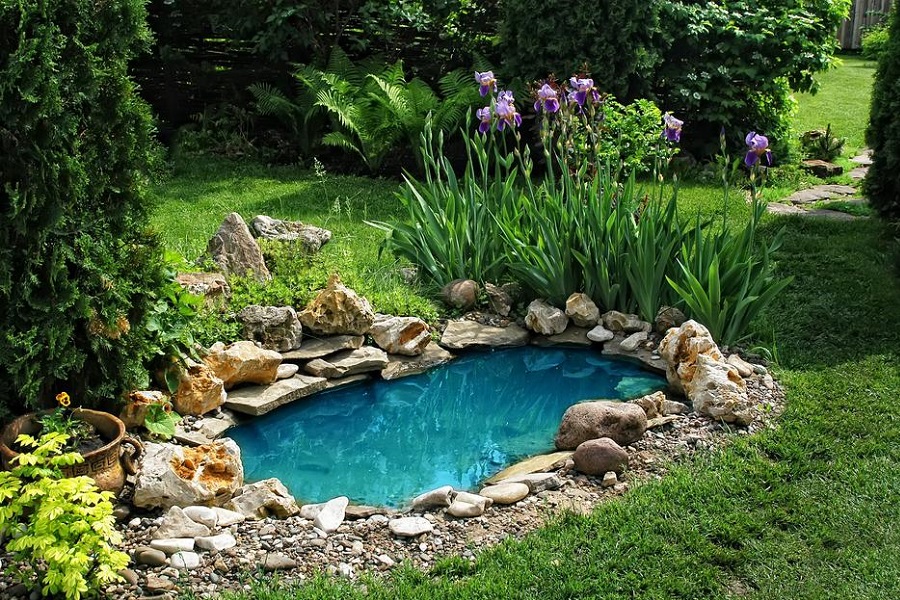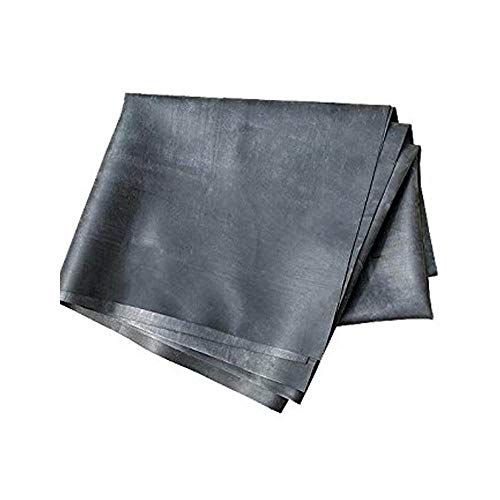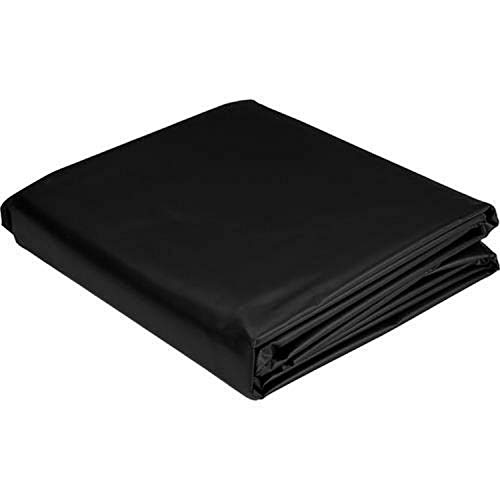When building your own fish pond, one of the choices you’ll have to consider when planning the project is which type of fish pond liner you’re going to use.
If you’re building a large Koi fish pond, then a concrete built pond would be a good option.
However, if you’re only building a smaller or more basic fish pond, then a flexible pond liner would be a more effective and also popular choice. The factors to take into consideration are the size of your fish pond and the actual budget as well.

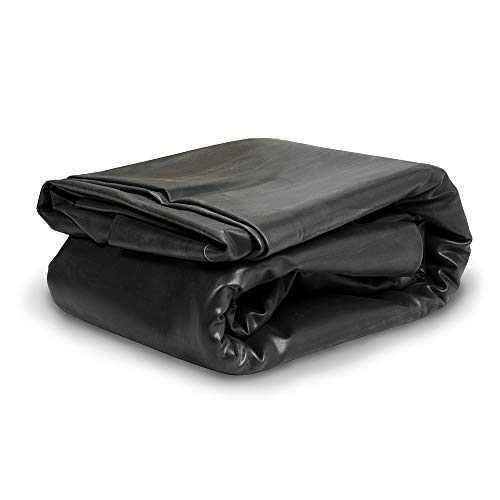




In the following article, we’ll take a look at some of the best fish pond liners available on the market and why you should invest in them.
Contents
Best Fish Pond Liner
Check out these other popular picks on this category:
1. Best for Fish: Aquascape PRO Grade EPDM Boxed Liner for Pond
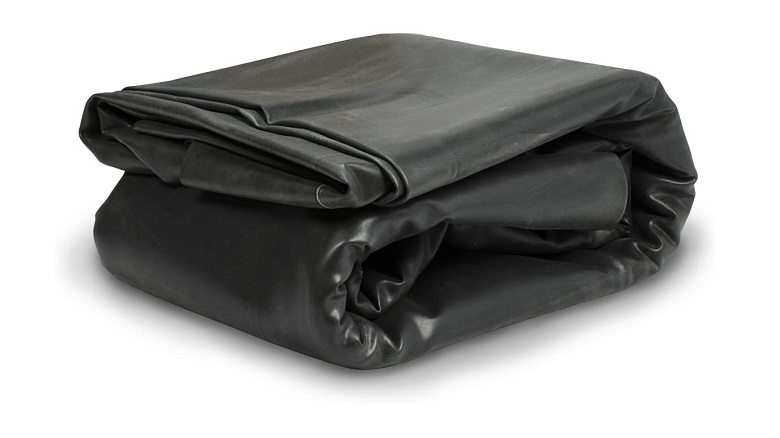
When building a fish pond, the underlayment and liner are the foundation of the pond. So if you choose an inferior quality or low- grade pond liner, it will probably lead to a possible leaky pond, costly repairs, and headaches.
Aquascape fish pond liners are the industry leaders when it comes to reliability and quality. It is also backed by Aquascape’s industry-leading 20-year guarantee making it the choice of professional contractors and discerning pond builders around the world.
Aquascape also sends out certified and pre-qualified contractors that are the best pond builders in the business. These contractors are trained and highly experienced in designing and building beautiful ponds, fountains, and waterfalls. When you deal with Aquascape, you have peace of mind knowing that you are choosing a brand trusted by building professionals and homeowners.
Some of the advantages of the Aquascape fish pond liner is its superior elongation and lay-flat characteristics, ease of installation without the need for extra or special tools, as well as exceptional resistance to ozone, solar UV, and oxidation.
Pros:
- Superior elongation
- Lay-flat characteristics
- Resistance to oxidation, ozone, and solar UV
Cons:
- Prone to leakage
Product specifications:
- Dimensions: 10 x 12 feet
- Weight: 1 pound
- Material: 45Mil Epdm Pond Liner
- Ideal membrane for retaining water in Koi and fish ponds, Pondless Waterfalls, and other water features
- Aquascape liner leads the industry in quality and reliability, making it the ideal choice for discriminating pond owners and professionals
- Backed by an industry-leading 20-year guarantee, the 45 mil thickness provides superior durability while maintaining the ability to stretch for ease of installation
2. Runner up: TotalPond pond skins Pond Liner

The TotalPond pond skins Pond Liner is designed by engineers to weigh 30% less than the other 20 mil PVC liners. However, it is still as flexible and strong as these other pond liners. They are also reinforced with a strong polyester weave that is placed between the layers of PVC.
The TotalPond pond skins Pond Liner contains a textured surface that leads to positive bacteria growth by providing the right foundation that is also an environmentally friendly one. These PVC liners are also puncture-resistant and UV resistant. This ultimately ensures years of use.
Pond liners come in various sizes, and it is recommended that you order a larger size than the hole you are covering since you can always cut off extra pieces. However, if you order a size too small, then it’s basically worthless to you.
You can also seam together several pieces of liners to form a large one. Also, be sure to add an extra layer of underlayment before installing the liner. This will keep tears and punctures at bay. Some alternatives for underlayment include old carpets, sand, and any robust sheet of fabric.
After allowing the liner to overlap onto the ground, secure it in place with shale, rocks, and other natural material.
Pros:
- Lightweight, easy to install
- Reinforced with polyester weave for additional durability
- Textured surface for positive bacteria growth
Cons:
- Liner is too thin for use in winter
Product specifications:
- Dimensions: 13 x 20 feet
- Weight: 23.3 lbs
- Material: PVC
- Make your large pond dream a reality! The TotalPond 13 ft. x 20 ft. PVC Pond Liner is suitable for holding water for a large in-ground or above-ground paver pond up to 1,600 gallons.
- Easy to install: Flexible, PVC material that is 33% lighter than standard EPDM liner, making it easier to create custom-shaped water features.
- Fosters a natural pond environment: Black liner blends into the pond environment to create a more natural look. UV-resistant PVC material won’t fade. Its textured surface also provides the right foundation for an environmentally balanced habitat.
3. Alternatives: Anjon Lifeguard EPDM Pond Liner

Pond liners are the foundation of any water garden, Koi pond, or waterfall feature. LifeGuard pond liners are the best choice for installers and feature owners around the globe. The Underguard underlayment protects and promotes the lifespan of the pond liner, and they both work together to bring unmatched quality to your backyard.
These pond liners are marketed in hundreds of pond kits and installed in thousands of water features worldwide. This is due to their reliability and reputation. These pond liners resist UV deterioration and do not contain plasticizers, which may become brittle, leading to splits and cracks.
LifeGuard pond liners are virtually indestructible and also unaffected by rot, mildew, hydrocarbons as well as freeze-thaw cycles. The pond liners are also versatile and used in a wide variety of applications such as skimmers and waterfalls, fish hatcheries, retention, and Koi ponds and pond free waterfalls.
They are certified fish and wildlife safe by Guardian Systems Inc. and easily attach to skimmers and filtering waterfalls. They can be easily seamed and are compatible with hose and pipe penetration without leaks.
LifeGuard pond liners are compatible with a range of water feature projects. It fits into corners and follows the contours along the sides and bottom of your pond. They fit well in ponds with planting shelves.
They also fit biological water filters, shelves identity to biological waterfall filters, skimmers, bottom drains, filter wires, and other filters that require liner attachments. Ultimately, they create a safer and healthier environment for plants, fish, and wildlife.
The results of these claims are available on the manufacturer’s website. The pond liners are also able to withstand extreme temperatures between 170 degrees Fahrenheit to minus 40 degrees Fahrenheit.
Pros:
- Durable and puncture-resistant
- Resistant to UV deterioration
- Certified fish and wildlife safe
Cons:
- Contains a seam in the middle which makes it prone to future weakness
Product specifications:
- Dimensions: 8 x 10 feet
- Weight: 10.88 LBS
- Material: EPMD
- 45-Mil EPDM Rubber Pond liner with 25-Year Warranty
- Durable, puncture resistant, extremely versatile for use in waterfall features, pond kits, water gardens, retention basins, koi ponds, aquaponics, lakes, stream liners, and fish hatcheries.
- Does not contain plasticizers, which become brittle and cause cracks or splits.
4. Best Durability Winner: Firestone EPDM Rubber Pond Liner

The Firestone EPMD pond liner and is pre-cut and boxed. There are flexible and creative designs, and the liners are environment and fish friendly. It is one of the easiest pond liners to maintain, and they are designed to last. These pond liners are 15′ x 20′ and approximately 45 inches thick.
Pros:
- Pre-cut and boxed
- Flexible designs
- Environment and fish-friendly
Cons:
- Product is expensive
Product specifications:
- Dimensions: 15 x 20 feet
- Weight: 90 lbs
- Material: EPDM rubber
- EPDM rubber pre cut and boxed pond liner
- Flexible for creative designs
- Environmentally friendly; fish friendly
5. Runner Up: POND BOSS Pond Skins Liner

Pond Boss specializes in the latest innovative, and cost-effective water features and gardening products that help you create, enhance, and maintain your own pond, fountain feature, and waterfall.
Pond Boss provides you with eco-friendly, and durable equipment such as UV filtration systems, Low water shut off pumps, non-toxic water treatments, pond liners, accessories and so much more.
They’ve been bringing high-quality gardening products to the public for over a decade. Their speedy and reliable customer care team is always ready to assist you in creating and maintaining your very own backyard garden feature.
Pros:
- Durable
- Safe for fish
- Easy to install
Cons:
- Prone to leaking
Product specifications:
- Dimensions: 10 x 13 feet
- Weight: 11 lbs
- Material: PVC
- Durable Pond Liner
- Safe For Fish
- Easy To Install
Flexible vs. Preformed vs. Concrete Floor
Deciding on the primary type of floor is your first step towards your dream pond. We are here to ensure that you are well informed about these three main types of pond floor. Let’s jump into learning about these foundations:
Flexible liners
Flexible floor liners are undoubtedly the most inexpensive types of pond liners. These flexible liners are usually purchased in custom cut sizes according to your pond’s size. Flexible liners can cover any irregularly shaped pond without much effort. Flexible liners are an excellent choice if you’re unsure about your pond size.
If you decide to expand your pond, you can easily modify the liners according to your needs. The integration of this liner is relatively straightforward, given its ability to fold and fit.
We highly recommend flexible liners as they are the cheapest lining solutions in the pond industry. If worked and adjusted adequately, these flexible liners can cleanly cover any edge without any significant issues. You will indeed be putting way less effort than concrete liners, so the material is excellent for time-sensitive backyard projects.
You might have to measure the liners more than your original need. If you end up with a small sheet, be ready to fill your pond or consider welding or gluing it. Let’s not forget the different specifications of flexible liners available on the market. You can buy these liners with various coatings, thicknesses, and flexibility levels.
Preformed liners
As the name suggests, these liners are already made in a factory. They are usually made using hardened rubber or plastic, so the shape never shifts or changes under the soil. These hard-shelled liners are widely available on the market and in various sizes and shapes.
The most spectacular feature of these liners is their ease of operation. Since they are already in form, you do not have to dig up an exact hole that looks like a pond. You dig up a standard hole big enough to fit the hard-shell casing inside the hole. Once you place the liner tub into the ground, you have a perfectly working pond without much effort.
We highly recommend preformed liners for people foraying into the pond world. As first-time pond owners do not know the ins and outs of building a pond, they can very easily create one without the fear of ruining it.
On the other side, you might have to search highs and lows to find the pond shell that works for you. People who wish to build a big pond will indeed have a hard time finding a decent-shaped pond liner that is big enough for their preference. Most liners are small in shape and thus are a perfect solution for first-time pond owners.
Concrete floor

Concrete liner is the most durable option of the three. These liners can withstand any temperate or climate condition for a lifetime. You might have to change other liners of your ponds regularly, but concrete is bound to stay in mint condition forever.
However, many pond owners prefer preformed liners over concrete because of their high cost. It is undoubtedly not a project for a single person, especially if the person is inexperienced. Even if you have previous experience in pond building, the concrete mixture alone costs more than the entire setup of a flexible or performed pool. Therefore, most people turn towards the other two liners.
However, you do have the option to pass on the backbreaking work to a professional. But ensure that the contractor company is well equipped with the process and does the job with excellence. Keep track and see whether the liner is thoroughly treated or not. Many ill-constructed ponds face lime leaching, which causes pH imbalance, ultimately harming the pond’s living organisms.
We would advise you to go around and get quotes from a few companies and choose the one that best suits the bill. Concrete liner isn’t the most feasible for most pond owners, but if you are determined to build a big pond that doesn’t require any liner maintenance, we recommend this solution.
Which is the best?
There is no universal answer that suggests which one is better of the three, but if you are a newbie pond owner, the concrete liner isn’t the most appropriate option for you. If you enjoy small ponds and are not planning to expand the pond, we recommend going with preformed ones.
They are also the quickest to install and require no professional interference. And finally, if you are on a tight budget or want to have the flexibility to change the pond’s size and shape regularly, then going for the flexible liner is the best option for you.
Pros and Cons of Various Types of Pond Liners
To help you find the best material for your pool liner, we have carefully created these five types of material that are best suited for any pond.
1. PVC Liner

Polyvinyl Chloride liners, popularly called PVC liners, are one of the most inexpensive flexible pond liners. These liners have a dedicated lifespan of 18-30 years, depending on surrounding conditions and fixtures.
Pros of PVC
- Unmatched flexibility: PVC is trendy because of its unmatched flexibility. This material is one of the oldest and most popular pond liner materials in the industry. You can easily fold these liners without adding any surface cracks. You can very easily fit these into any crevices to make your pond look more presentable.
- Highly inexpensive: PVC is exceptionally inexpensive as compared to other liners. Its affordability is the number one reason for its popularity.
- Easy to seam or weld: You can very quickly join two pieces of PVC sheets without any practical issue. Apart from that, these liners also join using glue or adhesives.
Cons of PVC
- Not the safest for fish: Since PVC isn’t naturally very flexible, the plasticizers and other additives make it flexible. These chemicals make PVC unsuitable for fish. PVC also contains trace if not high amounts of arsenic and other chemicals that can be toxic to fish and other aquatic lives.
- Susceptible to splits and crack: PVC is prone to cracks, especially if exposed to cold weather or direct sunlight. As it has low resistance to UV resistance, it usually results in premature degradation of the liner. As an owner, you will need to change the layer often.
2. RPE Liner
Reinforced Polyethylene has many benefits, like LLDPE but with comparatively lesser flaws. Many RPE companies boast that this liner can last for more than 40 years.
Pros of RPE Liner
- Durable: Since the RPE liner is reinforced, it is exceptionally durable than LLDPE or HDPE liners. It is highly puncture-proof and robust even under immense pressure.
- Lighter and Thinner: RPE liners are extremely thin and lightweight, which makes it easy for people to work with them. Since it is lighter, the material poses no issues during transit and installations.
- Fish Safe: Unlike PVC, this material is fish-safe. Pond owners who are highly worried about their fish and aquatic life can buy this liner without thinking twice.
Cons of RPE Liner
- Stiffer than the competition: RPE liners aren’t the most foldable material on the market. They are stiffer than HDPE, making it hard to adjust the liner to ponds, especially near tight corners.
- Expensive: The most crucial downside of this liner is its price. RPE liners are comparatively expensive than HDPE and LLDPE, even if the base materials of these three liners are the same.
3. EPDM Liner
Ethylene propylene diene monomer is very popular for its flexibility. EPDM is noted to last for more than 27 years when covered under the right conditions.
Pros of EPDM:
- Excellent grip: EPDM has the quality of not expanding or contracting even under high and low pressure. Its grip makes it relatively easy for the liner to keep its hold on rough surfaces.
- Flexible: This liner is incredibly soft yet durable. The soft characteristic allows the liner to fold on all corners and adjust to highly unique pond shapes with ease.
- Do not crack: As the material is reasonably resilient to cold, it is prone to light cracking at low temperatures.
- Easy to adhere: EPDM liners can firmly adhere to other sheets with the mere use of liner tape. This positive gives you the freedom to expand the pond.
Cons of EPDM
- Comparatively heavy: This material is hefty as compared to other liners. Its heavyweight usually increases the shipping fees, making it highly inconvenient for budget-conscious customers.
- Subpar chemical resistance: EPDM has a low chemical resistance and is highly vulnerable to solvents and oils, making it ill-fit for huge industrial ponds.
4. Fiberglass Liner
You will find fiberglass in most preformed pond liners. You can expect this liner to last anywhere between 20-25 years maximum.
Pros of the Fiberglass liner
- Sturdy: As fiberglass is a solid material, it is exceptionally sturdy when added with other elements. It does not require any surrounding support of soil or stones.
- Convenience: If you are a huge fan of raised ponds, consider fiberglass liner as your base material for the preformed shell. Because of its ability to stay in shape, you can install it above the ground to create a raised pond.
- Highly durable: Fiberglass is exceptionally durable and does not leak or crack even when exposed to low or high temperatures. Most plastic or rubbers tend to break; therefore, consider investing in fiberglass if you want a highly durable liner.
Cons of the Fiberglass liner:
- Expensive: These liners are relatively expensive. Even the base model costs a lot as compared to other options on the market.
- Limited structural pattern: As liners made with these materials are pre-made, users get a small selection of styles, sizes, and patterns to choose from.
5. HDPE Liner
These High-density polyethylene liners are also called as reinforced polyethylene liners. HDPE is indeed one of the best choices because of its impressive lifespan of more than 36 years.
Pros of HDPE Liner
- Puncture resistance: HDPE liners have a strong puncture resistance than PVC or EPDM liners. Since water doesn’t seep even under high pressure, users enjoy its puncture resistance for their big ponds.
- Weldable: You can easily weld two HDPE liners together to create a strong bond. Welding with a heat gun is always better than sticking two pieces with liner tape.
- Fish safe: This liner has a high chemical resistance, and it is non-toxic and highly safe for fishes and aquatic life. It is also affordable considering its positives.
Cons of HDPE liner:
- Tends to expand in high temperatures
- HDPE can become loose by expanding under extremely high temperatures. Users should keep in mind that this liner tends to stress crack.
Pond Liner FAQ
What is a pond liner?
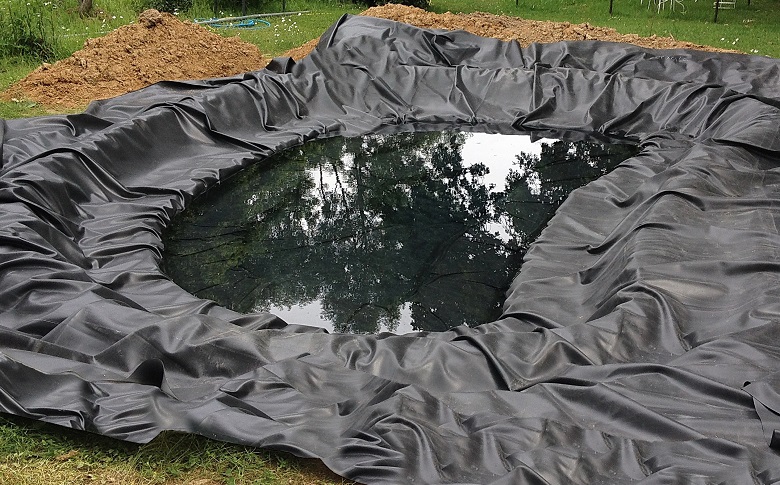
A pond liner, in essence, is a watertight geomembrane that is used for water retention. Not only is it used in the construction of ponds, but lakes and rivers as well.
However, they do need to be protected from sharp objects below the liner and from being ripped or punctured by other objects that are underneath the river or pond.
This is why water filters and pumps are available. They keep the want clean and sharp objects away. Protection is offered by layers of concrete, sand, fiber matting, and other materials as well.
These pond liners are made in rolls and can therefore be purchased in various different sizes. Just bear in mind that you don’t want to order a pond liner that is too small as it will not fit properly in your pond. Likewise, you don’t want a liner that is too big as it will be a waste of money.
So it is recommended that you buy a liner that is slightly bigger than what you actually need. This way, you are safeguarding yourself from going too small, and if it is slightly bigger, you can trim off the excess.
What size pond liner do I need?
There are a lot of tools available online to calculate the size of the pond liner you need. The calculation is automatic after you enter some required details.
Calculating the correct size of pond liner needed is crucial as you don’t want something that is too small as it is not going to fit; likewise, you don’t want a liner that is too big as it will be a waste of money and other pond supplies.
So the rule of thumb is that once you’ve found the right size of pond liner, always order a size that is slightly larger than that. This is to ensure that it’s definitely going to fit in your pond and also leave a little room for error.
So if it is slightly too big, all you need to do is just simply trim off the excess. Either way, it’s always better to go bigger rather than smaller. A bigger liner will need some adjusting to fit your pond while a small one is of no use to you.
How to install a pond liner?
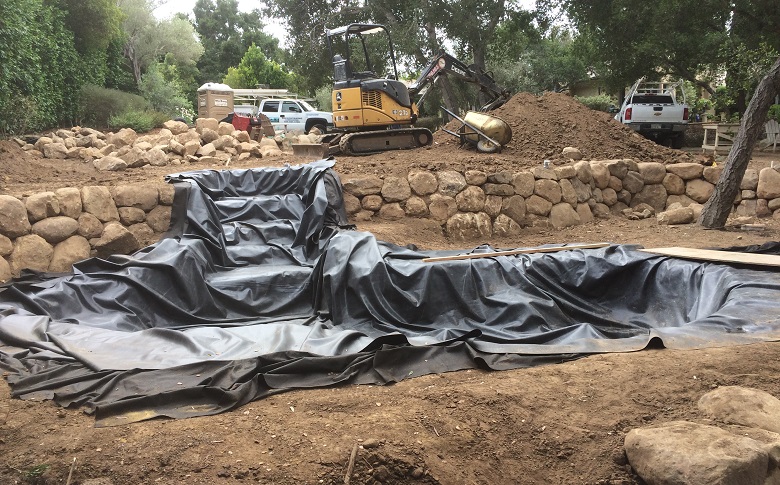
Mark out the area that you intend to build your pond using line marking paint, sand or a hose. Prior to digging to the desired depth, decide how many steps or shelves you want in your pond.
The steps will make handy exit points should any wildlife fall into the pond. To create a shallow water zone for plants, the first step should be around 20-45 cm deep.
There are no hard and fast rules when it comes to how deep a pond should be, so use your discretion. However, you should be aware that the deeper the pond, the easier it will be to maintain.
Koi ponds should be approximately 1 to 1.5m deep as these are the requirements. Your local council will make you aware of any regulations governing the depth of ponds, so be sure to check with them.
Once the hole has been dug, you can then start to give it some shape. It would help if you also used this time to make sure that there aren’t any roots, rocks or sharp objects on the base or sidewalls.
A shovel will ensure that you get the base smooth.
In this step, you should focus on what is needed for the pond equipment such as electrical cable trenches and plumbing. You can conceal pump cords and plumbing by capping; however, in many cases, the cable and hose are still visible.
If you are not sure of the regulations regarding electrical power cables, consult a certified electrician.
Consider the pond filter in use when considering plumbing. Always seek advice pertaining to pond filters before finishing off the outer areas of your pond to ensure that plumbing has been catered for.
In the next step, dig a 15cm wide x 15cm deep trench to create a capillary barrier which will prevent runoff getting into the pond and polluting it with fertilizers and pesticides.
It would help if you now chose a high-quality liner. Some of the best liners are reinforced polyethylene and EPDM. Your liner should offer tear resistance, flexibility, and strength. It is also better to order a slightly bigger size than is actually needed than to order a smaller size.
Before installing the pond liner, you should put down an underlayment. This extra layer works as padding against sharp objects, rocks and roots. It’s also puncture resistant prolonging the life of your liner and pond.
Once this step is fulfilled, you can lay down your pond liner. It should be laid directly on top of the underlayment and should be pulled taut. The liner should rest on the bottom of the pond, walls and shelves.
Place smooth rocks around the edges to hold the liner in place as you slowly fill the pond with water.
How to find a leak in a pond liner?
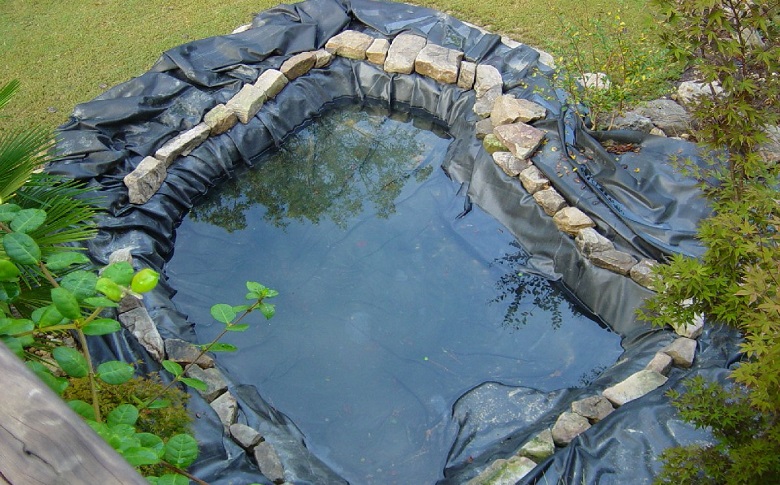
To check for leaks in the pond liner once it has been installed, you can use the milk squirt method. The liner will need to be inspected once the water level reaches the point where it is no longer dropping.
Simply put some milk in a spray bottle and spray it along the edges of the pond. If there are no holes, the milk will cloud the water. But if there is a hole in the liner, the milk will flow towards the hole.
How do I fix a pond liner leak?
There are a few ways that you can repair a pond liner leak depending on the time frame, and budget that you have. Using a rag, clean around the hole to remove algae and dirt. It is possible to fix the leaky liner without draining the water by using a specific type of sealant. It is, of course, safe for fish and plants.
You will need plastic disposable gloves as the sealant is extremely sticky. Once you’ve located the hole in the liner, place the sealant in a caulking gun and squeeze it into and around the hole in the liner. In fact, you should smear it over and around the hole.
This will work if it is a tiny hole. If the hole is large, you should cut a small piece of pond liner from the edges and use it to patch the hole. You can place it over the silicon.
Conclusion
It is always best to do your research before building a pond in your backyard. There is a wide range of options on the market, and it can tend to be overwhelming when the time comes to make a choice.
Some of the key points to remember in times like these is that the liner should be flexible, durable and long-lasting. They should also be fish and wildlife-friendly. Also note that irrespective of how strong a pond liner is, it is not indestructible so remove any sharp objects from the pond before laying down the underlayment and pond liner.
Your pond liner should also be able to withstand the elements, irrespective of whether it is blazing hot or freezing cold.

Ian Sterling, founder of Fishlab.com, began his aquarium journey over 30 years ago, driven by a deep fascination for fish and their diverse personalities. His website, Fishlab.com, is dedicated to making fishkeeping accessible and enjoyable, offering beginner-friendly guidance, expert insights, and a community for aquarists to connect and share experiences.


